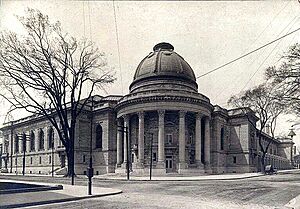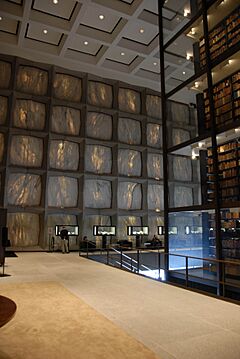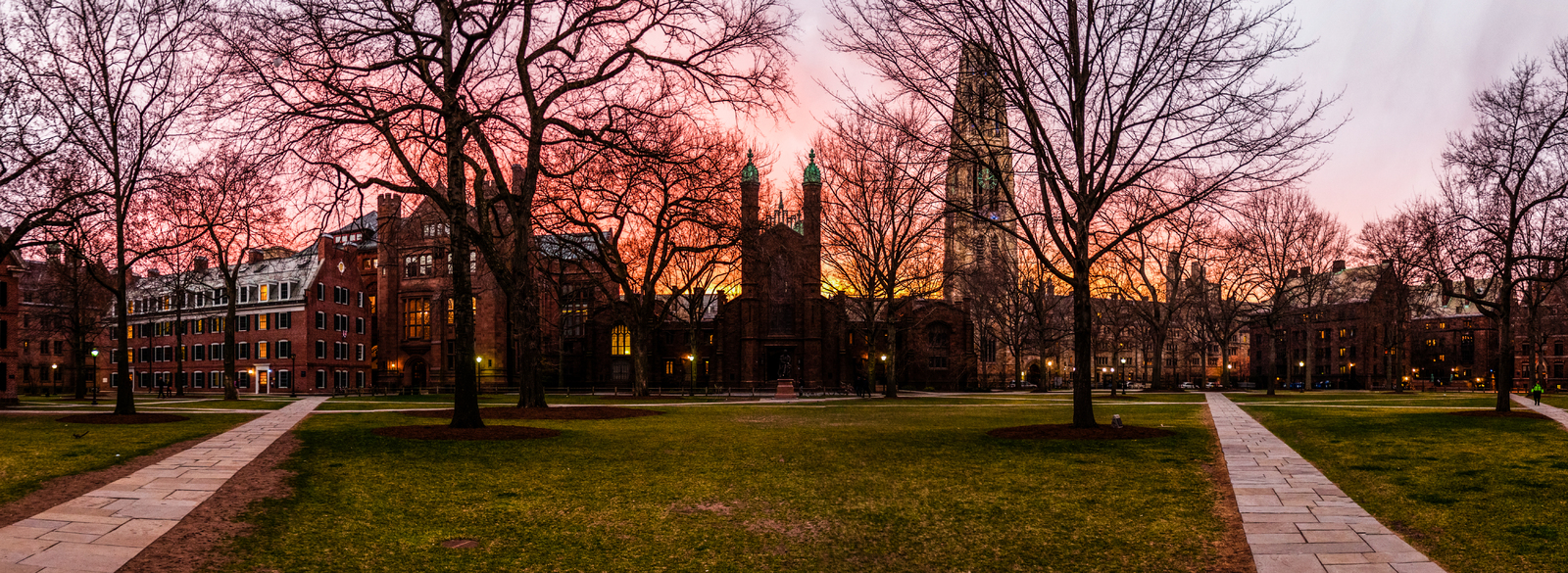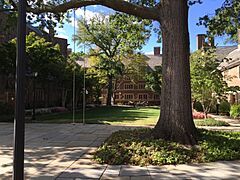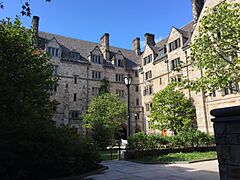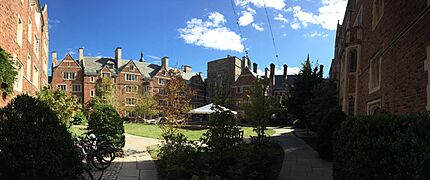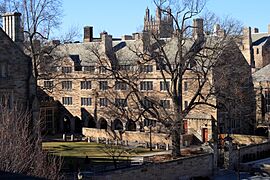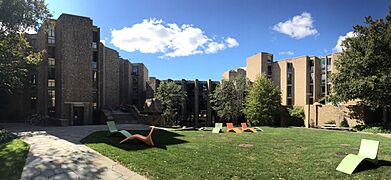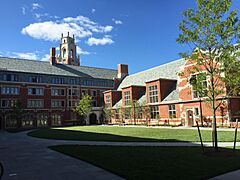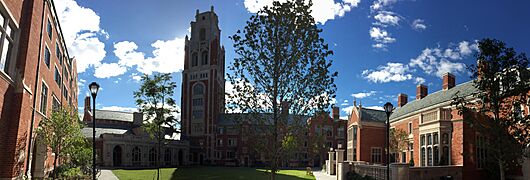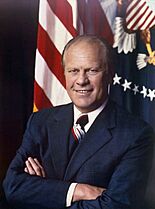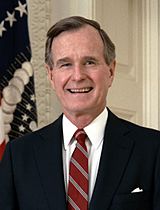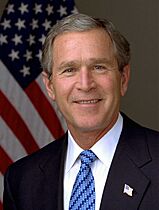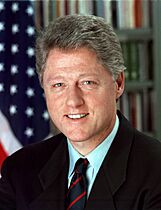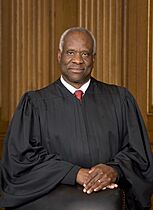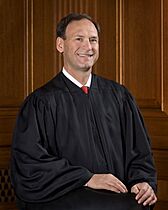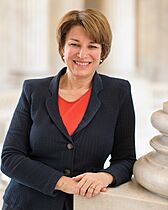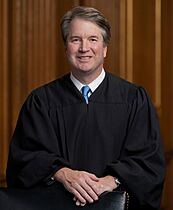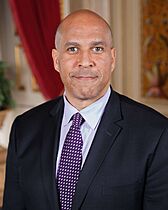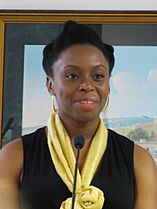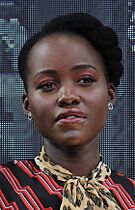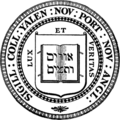Yale University facts for kids
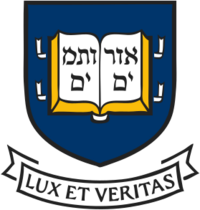
Coat of arms
|
|
| Latin: Universitas Yalensis | |
|
Former names
|
Collegiate School (1701–1718) Yale College (1718–1887) |
|---|---|
| Motto | Lux et veritas (Latin) אורים ותמים (Hebrew) |
|
Motto in English
|
"Light and truth" |
| Type | Private research university |
| Established | October 9, 1701 |
| Accreditation | NECHE |
|
Religious affiliation
|
Nonsectarian |
|
Academic affiliations
|
|
| Endowment | $41.4 billion (2024) |
| President | Maurie McInnis |
| Provost | Scott Strobel |
|
Academic staff
|
5,744 (fall 2024) |
| Students | 15,490 (fall 2024) |
| Undergraduates | 6,740 (fall 2024) |
| Postgraduates | 8,750 (fall 2024) |
| Location |
,
,
United States
41°18′59″N 72°55′20″W / 41.31639°N 72.92222°W |
| Campus | Midsize city, 1,015 acres (411 ha) |
| Newspaper | Yale Daily News |
| Colors | Yale blue & white |
| Nickname | Bulldogs |
|
Sporting affiliations
|
|
| Mascot | Handsome Dan |
 |
|
Yale University is a private research university located in New Haven, Connecticut, United States. It is part of the Ivy League, a group of eight famous universities in the Northeastern U.S. Yale was founded in 1701, making it the third-oldest university in the United States. It was one of the nine "colonial colleges" started before the American Revolution.
Yale began as the Collegiate School in 1701. It was started by religious leaders from the Connecticut Colony. At first, it mainly taught ministers about religion and ancient languages. Over time, it added subjects like humanities and sciences. In the 1800s, Yale grew to include graduate and professional studies. It awarded the first PhD in the U.S. in 1861 and became a university in 1887. Yale's student and teacher numbers grew quickly after 1890. This was due to more buildings and science research programs.
Yale has fifteen different schools. These include the original Yale College for undergraduate students, the Yale Graduate School of Arts and Sciences, and Yale Law School. The university is managed by the Yale Corporation. However, each school's teachers decide on their own courses and degree programs. Besides its main campus in downtown New Haven, Yale also has sports facilities in western New Haven. It owns a campus in West Haven, and forests and nature areas across New England. As of 2023, Yale's special fund (endowment) was worth about $40.7 billion. This is the third largest fund of any school. The Yale University Library has over 15 million books. It is the third-largest academic library in the U.S. Yale's student athletes are called the Yale Bulldogs. They compete in NCAA Division I sports as part of the Ivy League conference.
As of October 2024, many famous people have been connected to Yale. This includes 69 Nobel Prize winners, 5 Fields Medal winners, and 3 Turing Award winners. Yale has also educated many important alumni. These include 5 U.S. presidents, 10 Founding Fathers, and 19 U.S. Supreme Court justices. Many other alumni are leaders in government, business, and the arts. Yale's current teachers include many members of important national academies.
Contents
History of Yale University
How Yale Began
Early Days of the Collegiate School
Yale's story started on October 9, 1701. The Colony of Connecticut passed a law to create a "Collegiate School." The goal was to train ministers and other leaders. Soon after, ten religious ministers, all graduates of Harvard, met to donate books for the school's library. This group, led by James Pierpont, is known as "The Founders."
The school was first called the "Collegiate School." It opened in the home of its first leader, Abraham Pierson. He is considered Yale's first president. In 1703, the school moved to Saybrook. Then, in 1716, it moved to New Haven.
How Yale Got Its Name
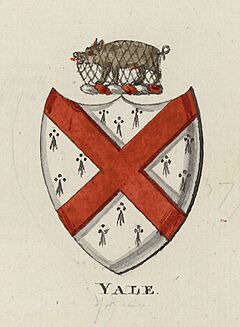
In 1718, a businessman named Elihu Yale was asked to donate money for a new college building. Elihu Yale had made a lot of money working for the East India Company. He gave goods worth more than £560, which was a large amount of money back then. Because of his generous gift, the school changed its name to "Yale College." The name Yale comes from a Welsh family estate.
Around the same time, a Harvard graduate in England convinced 180 smart people to donate books to Yale. This shipment of 500 books in 1714 included the best books on English literature, science, philosophy, and religion. These books greatly influenced students at Yale.
What Students Studied
Students at Yale College follow a liberal arts program. This means they study a wide range of subjects. They also choose a main subject to focus on. Students live in special residential colleges.
Yale was influenced by big ideas of the time, like the Great Awakening (a religious movement) and the Age of Enlightenment (a time of new scientific and philosophical ideas). Early presidents helped develop the science courses. They also dealt with wars and student issues.
Many students of religion, especially in New England, thought Hebrew was important. They studied it along with Greek and Latin to read the Old Testament in its original language. President Ezra Stiles (1778-1795) made all first-year students study Hebrew. He is responsible for the Hebrew words on the Yale seal. In 1779, British forces threatened to destroy the college. But a Yale graduate, Edmund Fanning, helped save it.
Student Life and Groups
Yale was the only college in Connecticut for many years. It educated the sons of important families. Students could be punished for things like playing cards or damaging school property.
Students formed private societies where they could discuss ideas. The first ones were debating clubs: Crotonia (1738), Linonia (1753), and Brothers in Unity (1768). Linonia and Brothers in Unity still exist today.
Yale in the 1800s
In 1828, Yale strongly defended its focus on Latin and Greek studies. This was against people who wanted more modern languages, math, and science. Colleges in the U.S. had to balance new ideas with old traditions. Yale professors wanted students to have strong values and be able to adapt to a changing world.
In 1887, Yale College officially changed its name to "Yale University." The name "Yale College" then referred only to the undergraduate program.
Sports and Debates

Early Yale students were seen as smart, athletic, and patriotic. As time went on, students started to look up to sports stars. Winning big games became very important for students and alumni.
Yale, along with Harvard and Princeton, created unique American sports programs. The Harvard–Yale football rivalry began in 1875. Debates between colleges also became popular. The language used in sports was often used to describe these debates.
Around 1909–1910, football faced problems because of serious injuries. The presidents of Harvard, Yale, and Princeton worked together to make changes to the sport. They wanted to reduce injuries and prevent the government from stepping in. Their efforts helped make the game safer.
Growing Bigger
Yale slowly added more schools. The Yale School of Medicine opened in 1810. Then came the Yale Divinity School (1822), Yale Law School (1822), and the Yale Graduate School of Arts and Sciences (1847). In 1887, Yale College became Yale University. The university continued to grow, adding schools for music, forestry, public health, architecture, nursing, drama, and management.
This growth caused some debate. Some leaders worried that focusing on research would hurt the undergraduate education. They wanted to keep Yale's traditional values while also embracing new ideas.
Yale in the 1900s
Milton Winternitz led the Yale School of Medicine from 1920 to 1935. He focused on scientific medicine and also on "social medicine," which studies how people live in their environment. He created the "Yale System" of teaching, which had fewer lectures and exams.
Teachers at Yale
Before World War II, most top universities had very few teachers who were Jewish, Black, or women. Yale was similar. But by 1980, this had changed a lot. Many people from these groups became teachers at Yale. Most teachers in the arts and sciences also teach undergraduate courses. Over 2,000 courses are offered each year.
Women at Yale
In 1793, a young woman named Lucinda Foote passed Yale's entrance exams. However, she was not allowed to attend because she was a girl. Women began studying at Yale in 1892, in graduate programs. The first seven women earned their PhDs in 1894.
In 1966, Yale talked with Vassar College about combining to allow both men and women to study together. Vassar was an all-female school at the time. Vassar decided not to merge. Both schools then started admitting both men and women on their own in 1969. Amy Solomon was the first woman to officially enroll as a Yale undergraduate. The class of 1973 was the first to have women from their first year.
A few years after women were admitted, a lawsuit called Alexander v. Yale was filed. This case was important because it was the first to use a law called Title IX to argue that certain types of unwanted behavior toward female students could be illegal sex discrimination. Even though the lawsuit did not win in court, it changed how schools dealt with such issues. It led to Yale creating a special board and a Women's Center to help students.
Yale in the 2000s
In 2006, Yale and Peking University in China started a program for undergraduate students to study together in Beijing. This program ended in 2012.
In 2007, Yale's president, Rick Levin, said Yale had two main goals. First, to be excellent in teaching undergraduate students. Second, to train leaders in its graduate and professional schools.
In 2009, former British Prime Minister Tony Blair chose Yale as a location for his Faith and Globalization Initiative. Also in 2009, Yale, University College London, and their hospitals formed a partnership. They wanted to do research to directly improve patient care. In 2013, Yale opened Yale-NUS College in Singapore with the National University of Singapore. This was a new college that taught both Western and Asian traditions.
In 2017, Yale University renamed Calhoun College. It was named after John C. Calhoun, who supported slavery. It is now called Hopper College, after Grace Hopper, a pioneering computer scientist.
In 2020, some people on social media called for Elihu Yale's name to be removed from the university. They argued that Yale's early money came from activities connected to the slave trade.
In April 2024, Yale students joined protests across the U.S. against the Gaza war. They asked Yale to stop investing in military companies connected to the war. Over 50 people were arrested. Protests continued through the summer and into the new school year. In December, undergraduate students voted to support the call for divestment.
In July 2025, Russian authorities declared Yale University an "undesirable" organization. This banned its activities in Russia. They claimed Yale's activities aimed to harm Russia's territory and stability.
Yale Alumni in Politics
The Boston Globe newspaper said in 2002 that Yale has educated many top national leaders. Yale alumni have been on the presidential tickets for both major U.S. parties in many elections. Presidents who attended Yale after the Vietnam War include Gerald Ford, George H. W. Bush, Bill Clinton, and George W. Bush. Other important political figures like Hillary Clinton and John Kerry also went to Yale.
Many reasons are given for Yale's strong presence in politics. Some point to the active campus life since the 1960s. Others mention Yale's focus on training future leaders. There is also a strong tradition of volunteering at Yale. Some say that Yale's network of friendships and connections helps.
How Yale is Organized
Leadership and Schools
| School founding | |
|---|---|
| School | Year founded |
| Yale College | 1701 |
| Yale School of Medicine | 1810 |
| Yale Divinity School | 1822 |
| Yale Law School | 1824 |
| Yale Graduate School of Arts and Sciences | 1847 |
| Sheffield Scientific School | 1847 |
| Yale School of Engineering & Applied Science | 1852 |
| Yale School of Fine Arts | 1869 |
| Yale School of Music | 1894 |
| Yale School of the Environment | 1900 |
| Yale School of Public Health | 1915 |
| Yale School of Architecture | 1916 |
| Yale School of Nursing | 1923 |
| David Geffen School of Drama at Yale University | 1955 |
| Yale School of Management | 1976 |
| Jackson School of Global Affairs | 2022 |
The Yale Corporation is the main governing body of the university. It has 19 members. Yale has three main parts: Yale College (for undergraduates), the Graduate School of Arts and Sciences, and twelve professional schools.
Many women who held leadership roles at Yale later became presidents or leaders at other major universities. For example, Hanna Holborn Gray was interim president of Yale and later president of the University of Chicago.
Staff and Unions
Yale University staff are part of different unions. These unions help workers with their rights and contracts. Yale has had some disagreements with its unions over the years, sometimes leading to strikes.
Yale's Campus
Yale's main campus is in downtown New Haven. It covers about 260 acres. It includes the historic campus and a medical campus. In western New Haven, Yale has 500 acres of sports facilities, including the Yale Golf Course. In 2008, Yale bought a large complex in West Haven for labs and research. Yale also owns forests and nature preserves in New England.
Yale is known for its beautiful buildings, many in the Collegiate Gothic style. This style looks like old European castles or churches. Some famous modern buildings are also on campus. Hillhouse Avenue at Yale was once called the most beautiful street in America. In 2011, Travel + Leisure magazine listed Yale's campus as one of the most beautiful in the U.S.
Many of Yale's Gothic-style buildings were built between 1917 and 1931. They were paid for by Edward S. Harkness. These buildings have stone sculptures of college people and scenes from daily life. The architect, James Gamble Rogers, made these buildings look old on purpose. He even broke windows and repaired them in an old style.
The oldest building on campus is Connecticut Hall, built in 1750. It is in the Georgian style.
The Beinecke Rare Book and Manuscript Library is one of the largest buildings in the world just for rare books. It has a tall tower of books surrounded by special marble panels. These panels let in soft, warm light. Outside the library, there are sculptures by Isamu Noguchi.
Alumnus Eero Saarinen, a famous architect, designed Ingalls Rink and two residential colleges, Ezra Stiles and Morse. These colleges were inspired by an old Italian hill town.
Important Campus Buildings
Some other important buildings and landmarks on campus include Battell Chapel, Harkness Tower, Ingalls Rink, Payne Whitney Gymnasium, Peabody Museum of Natural History, Sterling Memorial Library, Woolsey Hall, and the Yale University Art Gallery.
Yale also has buildings for its secret societies. These buildings are private and have unique architectural styles.
Caring for the Environment
Yale's Office of Sustainability works to make the university more environmentally friendly. Yale aims to reduce its greenhouse gas emissions. Many campus buildings are designed to be energy-efficient. The Yale Sustainable Food Project brings local, organic food to dining halls. Yale is recognized as a leader in campus sustainability.
Yale and New Haven
Yale is the biggest taxpayer and employer in New Haven. It helps the city's economy. Yale's art galleries and other resources are free for everyone to visit. Yale also helps fund the New Haven Promise program, which pays college tuition for eligible students from New Haven public schools.
Yale has a complex relationship with New Haven. Many students volunteer in the community. However, city officials sometimes wish Yale would do more to help, especially since Yale's academic property is exempt from local taxes.
Campus Safety
Yale was one of the first universities to have its own police force, started in 1894. Besides the Yale Police Department, there are other safety services available for students. New Haven's crime rate has fallen a lot since the 1990s, making Yale's campus very safe compared to other schools.
Academics at Yale
Getting into Yale
Getting into Yale College as an undergraduate is very competitive. For the Class of 2026, Yale accepted only 4.46% of applicants. Most students (98%) graduate within six years.
Yale helps students with financial aid based on their need. This means they try to meet the full financial need of all accepted students. Most financial aid is in the form of grants and scholarships that students don't have to pay back. About half of Yale College students receive some financial aid.
Half of all Yale undergraduates are women. More than 39% are U.S. citizens from ethnic minority groups. About 10.5% are international students. Most students (55%) went to public high schools.
Yale's Collections

The Yale University Library has over 15 million books. It is the second-largest university library in the U.S. The main library, Sterling Memorial Library, holds about 4 million books.
Yale has several collections of rare books. The Beinecke Rare Book Library has a very large collection. The Harvey Cushing/John Hay Whitney Medical Library has important old medical texts and instruments.
Yale's museums are also very important. The Yale University Art Gallery was the first university art museum in the country. It has over 200,000 artworks. The Yale Center for British Art has the largest collection of British art outside the UK.
The Peabody Museum of Natural History in New Haven has research collections on anthropology, archaeology, and nature.
Rankings and Reputation
U.S. News & World Report ranked Yale fifth among U.S. national universities for 2025. Yale University is officially recognized by the New England Commission of Higher Education.
Internationally, Yale was ranked 11th in the 2025 Academic Ranking of World Universities. It was ranked 21st in the QS World University Rankings 2026.
Teachers, Research, and Ideas
Yale is a member of the Association of American Universities. It is known for its very high research activity. In 2021, Yale spent over $1.16 billion on research and development.
Yale's current teachers include many members of important national academies. Yale is also a top source of students who go on to earn doctoral degrees.
Yale's English and Comparative Literature departments were important in the "New Criticism" movement. Later, the Comparative Literature department became a center for "deconstruction," a way of analyzing texts. Yale's history department has also started important intellectual trends.
Yale also has about 1200 postdoctoral researchers. These are scientists who have finished their PhDs and are doing more research.
Life at Yale
| Race and ethnicity | Total | ||
|---|---|---|---|
| White | 32% |
|
|
| Asian | 23% |
|
|
| Hispanic | 16% |
|
|
| International student | 11% |
|
|
| Black | 9% |
|
|
| Two or more races | 7% |
|
|
| Unknown | 2% |
|
|
| Economic diversity | |||
| Low-income | 19% |
|
|
| Affluent | 81% |
|
|
Yale is a research university. Most of its students are in graduate and professional schools. Undergraduate students at Yale College come from many different backgrounds. About 10% are not U.S. citizens, and 54% went to public high schools.
Residential Colleges
Yale has a special system of residential colleges. This system was started in 1933 by Edward S. Harkness. He wanted to create a close-knit community like those at Oxford and Cambridge universities in England. Each college has a head and an academic dean. Teachers and other staff are also part of each college.
Colleges offer their own seminars and social events. However, all undergraduate courses are taught by the Faculty of Arts and Sciences. These courses are open to students from any college.
All undergraduate students belong to a college. They are assigned to one before their first year. Most students (85%) live in their college's buildings. Most first-year students live on the Old Campus, which is the oldest part of the university.
Yale's first colleges were built in the Georgian or Collegiate Gothic styles. Two colleges built in the 1960s, Morse and Ezra Stiles, have modern designs. Each of the twelve colleges has a dining hall, courtyard, library, and common room. The colleges are named after important alumni or places in Yale's history. In 2017, Yale opened two new colleges.
Renaming Calhoun College
For many years, people wanted to rename Calhoun College. It was named after John C. Calhoun, who supported slavery. In 2015, after a tragic event in South Carolina, calls to rename the college grew stronger. Students argued that Calhoun was a strong supporter of slavery.
In August 2015, Yale President Peter Salovey explained why the college would not be renamed at that time. He said Calhoun was an important political figure, but also acknowledged his support for slavery. He felt that keeping the name would help students learn from history. However, he did change the title of "master" for college leaders to "head of college" because of its connection to slavery.
Despite this, in February 2017, President Salovey announced that Calhoun College would be renamed for Grace Hopper, a pioneering computer scientist. This decision was met with different reactions from students and alumni.
Student Groups
In 2024, Yale had over 500 registered student groups for undergraduates. There are also many groups for graduate students.
The university has many student newspapers and magazines. Yale Literary Magazine is the oldest student literary magazine in the U.S., started in 1836. The Yale Record is the world's oldest college humor magazine, started in 1872. The Yale Daily News was first published in 1878.
Dwight Hall is a non-profit group that helps students volunteer in New Haven. Over 2,000 Yale students work on more than 70 community service projects. The Yale College Council (YCC) is the undergraduate student government.
The Yale Political Union (YPU) is a debate society started in 1934. It hosts student discussions on many topics.
Yale has many a cappella singing groups. The most famous is The Whiffenpoofs, which started in 1909.
The Elizabethan Club is a social club for students, teachers, and staff who like literature and art. Members can visit the club for conversation and tea. The club owns very rare first editions of famous books.
Secret Societies
Yale has several secret societies. These include Skull and Bones, Scroll and Key, and Wolf's Head. These groups are private and have their own unique buildings.
Traditions
Yale seniors have a tradition of smashing clay pipes at graduation. This symbolizes leaving their "bright college years" behind. The university's alma mater, "Bright College Years," was written in 1881. Students also consider it good luck to rub the toe of the statue of Theodore Dwight Woolsey on Old Campus, though actual students rarely do this.
In the past, a campus-wide game called Bladderball was popular. It involved a large inflatable ball. The game was banned due to safety concerns, but students have sometimes brought it back.
Sports at Yale
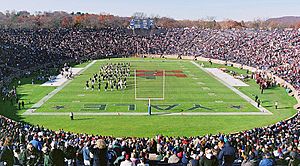
Yale has 35 varsity sports teams. They compete in the Ivy League Conference and other groups. Yale teams compete at the NCAA Division I level. Like other Ivy League schools, Yale does not offer sports scholarships.
Yale has many sports facilities. These include the Yale Bowl, which was the first "bowl" stadium in the U.S. It also has the Payne Whitney Gymnasium, one of the largest indoor sports complexes in the world.
In 1970, the NCAA banned Yale from sports for two years. This was because Yale allowed a Jewish player, Jack Langer, to play in college games after he played for Team United States in Israel.
In 2016, the men's basketball team won the Ivy League Championship. They then won their first-ever tournament game in the NCAA Division I men's basketball tournament.

In May 2018, the men's lacrosse team won their first-ever NCAA Division I Men's Lacrosse Championship. They were the first Ivy League school to win this title since 2001.
Yale crew (rowing) is the oldest college sports team in America. They won Olympic Games Gold Medals in 1924 and 1956. The Yale Corinthian Yacht Club, founded in 1881, is the oldest college sailing club in the world.
Yale students claim to have invented Frisbee by tossing empty pie tins.
The Yale Precision Marching Band supports Yale athletics. They are known for their unique, energetic style of performing.
Yale also has intramural sports. Students compete for their residential colleges in many different sports throughout the year. The college with the most points wins the Tyng Cup.
Songs and Mascot
One of Yale's most famous songs is the alma mater, "Bright College Years." The official Yale fight song is "Bulldog," written by Cole Porter. It is sung after touchdowns at football games. Other songs like "Down the Field" and "Bingo Eli Yale" are also sung.
The school mascot is "Handsome Dan," a Yale bulldog. Yale's Handsome Dan is believed to be the first college mascot in America, started in 1889. The school color, since 1894, is Yale Blue.
Student Well-being
Yale has received some criticism for how it handles student mental health. Some students have said that Yale's policies made them feel they had to leave school rather than get help. In 2018, one group ranked Yale as having the worst mental health policies in the Ivy League.
Students have reported that they sometimes hide their struggles to avoid being forced to leave. After a student's death in 2015, the university reviewed its policies. They renamed the "medical withdrawal" process to "reinstatement" and made it easier for students to return.
In 2022, Yale increased the number of mental health counselors. In 2023, after a lawsuit, the university changed "medical withdrawal" to "medical leave of absence." This new policy allows students on leave to keep their insurance and participate in some campus activities. Yale states that student well-being is a very high priority.
Notable People from Yale
Generous Supporters
Yale has had many people who have given large donations. Some of the most important include Elihu Yale, the Vanderbilt family, the Harkness family, and the Beinecke family. In 2013, Charles B. Johnson gave $250 million to build two new residential colleges, named after Pauli Murray and Benjamin Franklin. Stephen Adams's gift made the Yale School of Music tuition-free. David Geffen's gift made the David Geffen School of Drama at Yale tuition-free.
Famous Alumni
Yale has educated many famous people in different fields. About 71% of undergraduates go on to work, while 17% go to graduate school. Yale graduates have received many prestigious scholarships, like the Rhodes Scholarship and Marshall Scholarship. Yale is also a top producer of Fulbright Scholars. Many billionaires are also Yale alumni.
Many Yale alumni have become leaders in government and politics. Former U.S. presidents who attended Yale include William Howard Taft, George H. W. Bush, and George W. Bush. Gerald Ford and Bill Clinton attended Yale Law School. Other world leaders from Yale include prime ministers and presidents from Italy, Turkey, South Korea, and Mexico.
Yale alumni have also been important in the U.S. government. 19 justices on the U.S. Supreme Court have been alumni. Many U.S. Senators and Cabinet members also attended Yale.
Yale has produced many award-winning authors and writers, like Nobel Prize in Literature winner Sinclair Lewis. Famous actors and directors like Jodie Foster, Paul Newman, and Meryl Streep also went to Yale. Musicians like Charles Ives and Cole Porter are alumni. Many famous artists and architects, including Maya Lin and Norman Foster, also graduated from Yale.
In business, Yale alumni have founded major companies like Boeing, Time Magazine, Blackstone Group, and FedEx.
In academics, Yale alumni include Nobel Prize winners in economics and physics, and leaders of major scientific projects.
In sports, alumni include baseball players Ron Darling and Craig Breslow, football players Calvin Hill and Walter Camp, and Olympic athletes like figure skater Nathan Chen.
- Notable Yale alumni include:
-
27th President of the United States and Chief Justice William Howard Taft (BA, 1878)
-
38th President of the United States Gerald Ford (LLB, 1941)
-
41st President of the United States George H. W. Bush (BA, 1948)
-
43rd President of the United States George W. Bush (BA, 1968)
-
42nd President of the United States Bill Clinton (JD, 1973)
-
67th United States Secretary of State and Former U.S. Senator of New York Hillary Clinton (JD, 1973)
-
Associate Justice of the Supreme Court of the United States Clarence Thomas (JD, 1974)
-
Associate Justice of the Supreme Court of the United States Samuel Alito (JD, 1975)
-
Associate Justice of the Supreme Court of the United States Sonia Sotomayor (JD, 1979)
-
Senator of Minnesota Amy Klobuchar (BA, 1982)
-
Actress and filmmaker Jodie Foster (BA, 1985)
-
Associate Justice of the Supreme Court of the United States Brett Kavanaugh (BA, 1987; JD, 1990)
-
Senator of New Jersey, Cory Booker (JD, 1997)
-
Governor of Florida Ron DeSantis (BA, 2001)
-
Playwright, Author and National Book Critics Circle Award winner Chimamanda Ngozi Adichie (MA, 2008)
-
Actress Lupita Nyong'o (MFA, 2012)
Images for kids
-
Coat of arms of the family of Elihu Yale, after whom the university was named in 1718
-
Yale's four-oared crew team posing with the 1876 Centennial Regatta trophy, won in Philadelphia, Pennsylvania
-
Woolsey Hall c. 1905
-
Statue of Nathan Hale in front of Connecticut Hall
-
Yale University's Sterling Memorial Library, as seen from Maya Lin's sculpture, Women's Table. The sculpture records the number of women enrolled at Yale over its history; female undergraduates were not admitted until 1969.
-
The Yale Bowl, the college football stadium
-
The Walter Camp Gate at the Yale Athletic Complex
-
27th President of the United States and Chief Justice William Howard Taft (BA, 1878)
-
38th President of the United States Gerald Ford (LLB, 1941)
-
41st President of the United States George H. W. Bush (BA, 1948)
-
43rd President of the United States George W. Bush (BA, 1968)
-
42nd President of the United States Bill Clinton (JD, 1973)
-
67th United States Secretary of State and Former U.S. Senator of New York Hillary Clinton (JD, 1973)
-
Associate Justice of the Supreme Court of the United States Clarence Thomas (JD, 1974)
-
Associate Justice of the Supreme Court of the United States Samuel Alito (JD, 1975)
-
Associate Justice of the Supreme Court of the United States Sonia Sotomayor (JD, 1979)
-
Senator of Minnesota Amy Klobuchar (BA, 1982)
-
Actress and filmmaker Jodie Foster (BA, 1985)
-
Associate Justice of the Supreme Court of the United States Brett Kavanaugh (BA, 1987; JD, 1990)
-
Senator of New Jersey, Cory Booker (JD, 1997)
-
Governor of Florida Ron DeSantis (BA, 2001)
-
Playwright, Author and National Book Critics Circle Award winner Chimamanda Ngozi Adichie (MA, 2008)
-
Actress Lupita Nyong'o (MFA, 2012)
See also
 In Spanish: Universidad Yale para niños
In Spanish: Universidad Yale para niños






